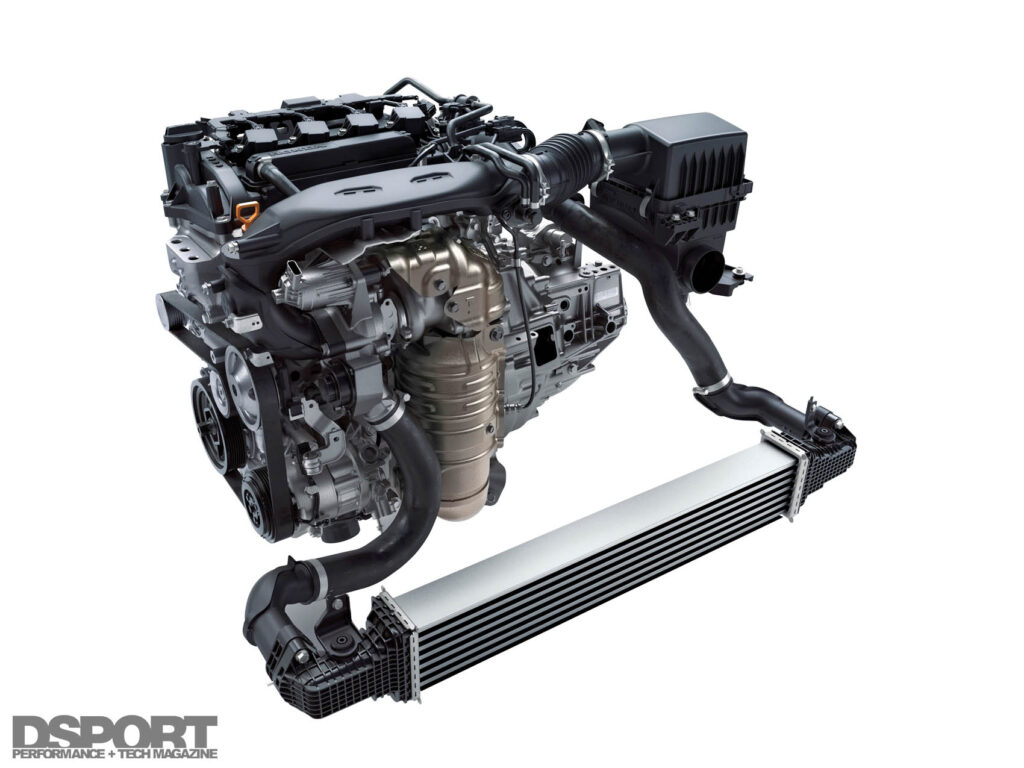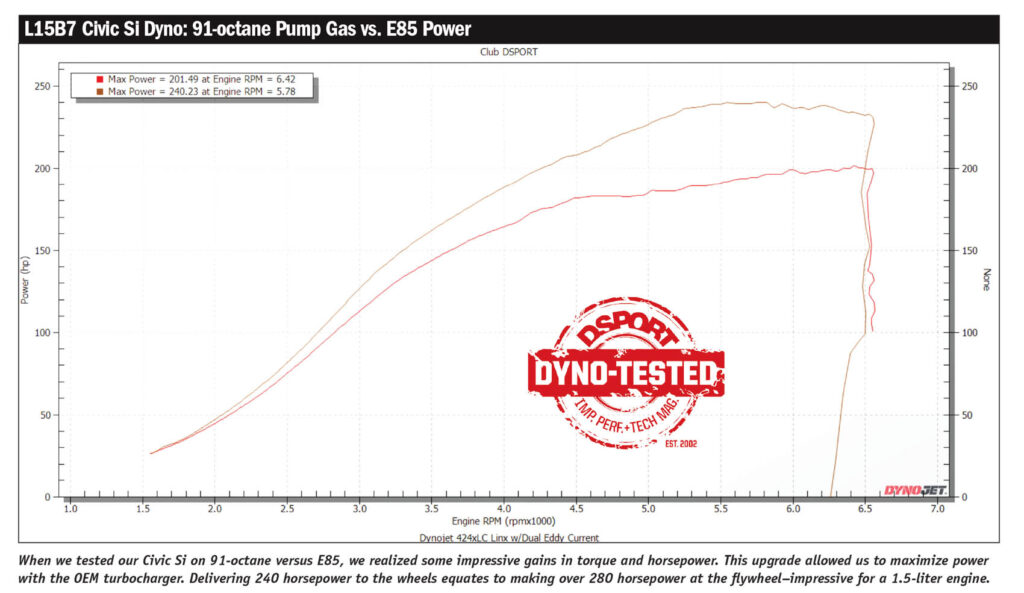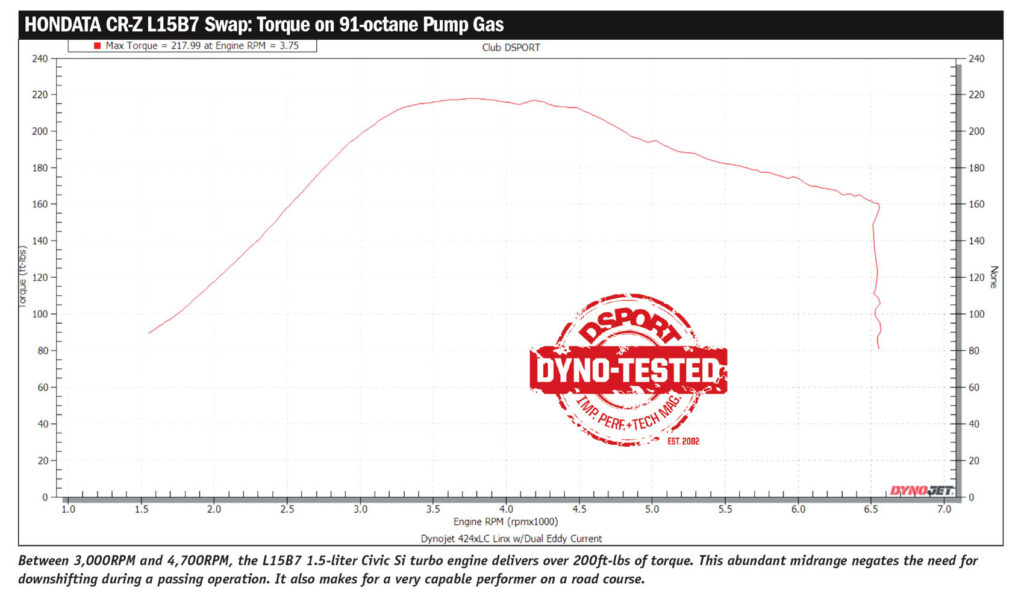More Power, Better Economy and BAR-Certified L15B7 Swap
DSPORT Issue #267
Text by Michael Ferrara
No matter how new you are to the performance market, chances are you know something about engine swaps. Old hot-rodders swapped small block Chevy (SBC) engines in place of Ford flatheads beginning in the late 1950s. This trend continued for the next 40 years with SBCs finding homes in domestic, Japanese and European engine bays. In the 90s, the Honda B-series engine would become the popular swap as thousands of Civic owners ditched the factory D-series engines for the benefits of the more powerful and technologically advanced B-series engines. Slightly after the turn of the century until the present day, those looking to swap most often selected Chevy LS and Honda K-series engines. Now, there is a new contender poised to become the most popular swapped four-cylinder over the next decade. After understanding the rationale of engine swaps and the performance, reliability and fuel efficiency improvements offered by Honda’s L15 engine, it’s hard to make a case against this high-tech, turbocharged Mighty Mouse.

Why Swap?
The end goal for an engine swap is to achieve higher performance, improved reliability and cost savings (and headache reduction) over improving the original engine to a like performance level. No sane person swaps in an engine that delivers less power or reliability or costs more to maintain. Younger enthusiasts and others that have more of a concern for the environment can also have increased appreciation for engine swaps that improve fuel economy and reduce emissions. Taking a look at just the Honda engines that have been popular for swaps shows how the swap engines were not just bigger in displacement, but better in terms of newer technologies.
History of Honda Swaps
The B-series swap commonly took place in Civics originally powered by a 1.5- or 1.6-liter D-series SOHC engine. The B-series didn’t always add displacement ( B16 swap was also 1.6-liters), but B17 and B18 swap options could up the displacement to 1.7 or 1.8 liters. On naturally-aspirated engines, more displacement meant more torque which could be used to improve performance. The B-series also had technological advances over the D-series they often replaced. All B-series engines were a Double Over Head Camshaft (DOHC) design that provided the opportunity for tuners to optimize engine performance by altering the intake and exhaust valve timing events independent of each other. The B-series engines were also more robust with stronger internals that could survive a bit of boost from an aftermarket turbo kit or up to a 100-hp shot of nitrous oxide. Some B-series engines also featured VTEC technology that allowed a very high horsepower per liter of displacement. While the B-series may remain a favorite of Honda performance enthusiasts, this once inexpensive option has gone up in price year after year as supply of these 25-to 35-year-old engines is vanishing.
K-series engines weren’t instantly liked or accepted by those that were fans of the B-series. Eventually, the K-series would prove that it was not just bigger (coming in 2.0- and 2.4-liter configurations), but also better than the B-series in many ways. New technologies such as iVTEC allowed some of the K-series variants to have variable cam timing (on the intake camshaft) expanding its powerband. The engines also featured a distributorless, coil-on-plug ignition system while factory ECUs advanced to use closed-loop lambda feedback under wide-open-throttle. Today, the K-series swap has become the most-popular 4-cylinder engine swap due to its high-output and relatively light weight. The aftermarket support for these engines is immense, which adds to its popularity.
While both the B-series and K-series options often add displacement with the swap, the Honda L15 swap instead delivers the ultimate replacement for displacement…technology. The L15 engine only displaces 1.5 liters, but the output of its best variants is higher than any B- or K-series engine offered. Turbocharging, direct injection, electronic wastegate control, and variable cam timing on both the intake and exhaust cams allow this 1.5-liter engine to perform like an engine twice its size when the pedal meets the metal. However, these same technologies also allow the 1.5-liter to deliver extreme efficiency under normal driving conditions. The engine also happens to have much lower emissions than any B- or K-series engine.
In the case of the Honda L15 swap, it checks all the boxes of a great swap consideration: more performance, increased reliability, higher efficiency and reduced emissions at a cost that’s lower than many other options due to the number of these engines that were produced.
Swap Realities
While the advantages of an engine swap can be very persuading, it’s important to understand the realities that follow the process. Choosing the wrong engine or wrong partners in the swap process can lead to a host of issues. First, improper planning will lead to the process taking more time and money than originally budgeted. Second, some swaps may not be eligible to be certified for your vehicle depending on the state where you reside. Third, emissions compliance may not be possible if you choose the wrong engine.

Worst-case Scenario
When HONDATA wanted to explore the merits of the L15 swap, it looked to see if the L15 swap could excel in a worst-case scenario. First, the goal of the swap would be to get it BAR-certified in a state known to pose extreme restrictions. Seeing that Hondata was based in California, it wouldn’t have to travel to another state to get the highest level of scrutiny. Second, Hondata would choose a 2015 Honda CR-Z as the recipient of the L15 swap. The fact that the recipient vehicle was originally a hybrid required some additional work to remove the electric motor and batteries from the vehicle. One additional benefit of this swap on this hybrid vehicle was that 100 pounds were removed from it in the process. While the donor and recipient vehicles were both Hondas, the CR-Z has minimal aftermarket support.
Plan and Process
The plan would involve swapping an L15B7 (2017-2021 Civic Si) engine and transmission into the 2015 Honda CR-Z. The donor engine, harness and ECU were acquired from a donor vehicle and the CR-Z was already in the HONDATA fleet. Part one of the plan would be to strip the engine, electric motor and batteries from the CR-Z. Once stripped, Hasport would work up the solution for the engine mounts and axles. With the engine mounted in the vehicle, new intercooler and charge pipes would be fabricated to make all the necessary connections. Jordan Distributors Inc (JDI) would be called upon to make the conversion harness. According to HONDATA, the hardest part of the process involved getting the EVAP system up to spec of the swapped engine (2016 Honda Civic standards). After coordinating the process with California’s Bureau of Automotive Repair (BAR), the referee from BAR spent about 90 minutes with the vehicle to put it on the dyno, check readiness codes and perform a vehicle number confirmation of the VIN number on the engine and the donor vehicle. All testing was done with HONDATA’s E.O.-approved calibration in the FlashPro.
Double the Power, Double the Fun
Compared to the original 111hp, 1.5-liter engine that is coupled to a 20hp electric motor with first-generation hybrid integration, the swapped 1.5-liter turbocharged L15B7 Civic Si engine delivers over 235 horsepower at the flywheel without the hinderance of an electric motor. That’s over 200 horsepower and over 215ft-lb of torque to the wheels. Double the power, a 100-pound weight savings and the banishment of the hybrid configuration definitely add up to double the fun. We had the L15B7-powered CR-Z for a week to do as we please. Whether it was cruising on the streets or battling for position on the freeway, this CR-Z didn’t disappoint. As a big fan of the original CR-X and not a fan (at all) of the original CR-Z, this L-swap definitely makes the CR-Z a very respectable performer that delivers a multiple of the thrills of a seriously-modified CR-X.
While there are many nitrous oxide controllers, they all have extremely limited capabilities compared to what is offered in a decent stand-alone engine management system. DSPORT is currently working with a few companies to see some 21st century nitrous controllers for those needing superior control but not having the access to a stand-alone engine management system. Hopefully, some of these will come to market in the next year or two.
That’s Not All…
Depending on where you live and the local and state emission laws, you may be able to tune your L-swap for flex fuel compatibility. This change alone can add an additional 40 horsepower to the wheels (what we realized on our 2019 Civic Si test vehicle). HONDATA is seeking a CARB E.O. for flex fuel in California, but it already has 49-state certification for its CANFlex systems that retail for just $595.



L15B7 Swap Ready
So you are sold on the L-swap, but you want an easier challenge than a CR-Z? In addition to the CR-Z, Hasport offers the engine mounts for L15B7 swaps into all three generations of the Honda Fit, 1992-1995 Civic, 1996-2000 Civic and the 1994-2001 Integra. Hasport also offers the axle conversions kits for most of these models. In 2025, Hasport hopes to also offer mount kits and axles for the 01-05 Civic, 06-11 Civic and 12-15 Civic too. JDI has developed a universal conversion harness to allow a 2016-2021 Civic non-Si or the 2017-2021 Civic Si L15 turbo engine into any vehicle. It also offers a plug-and-play version that allows customer to perform the L-swap into 92-00 Civics, 94-01 Integras, and the 93-97 del Sols. These harnesses include all emission connections to make them eligible for 50-state compliance. Remember that when you source the engine, you will need to source the engine harness, ECU, electronic pedal assembly and EVAP system from the donor vehicle.

The Bottom Line
The fun I had driving my friend’s 1995 Civic with a GSR B-series swap was the reason why my first new car purchase was a 1999 Civic Si (the first Civic coupe to be offered in the US with a B-series engine from the factory). There are many cars that would be much better had they simply had a different engine. Swapping over to one of the most technologically advanced four-cylinder engines available can not only add performance and reliability, but also deliver improved fuel efficiency and reduced emissions. When done properly, this swap can even be approved by your state’s authorities in most cases. If it’s time to take your project build to a new level, take the time to see if the L-swap is right for you.




